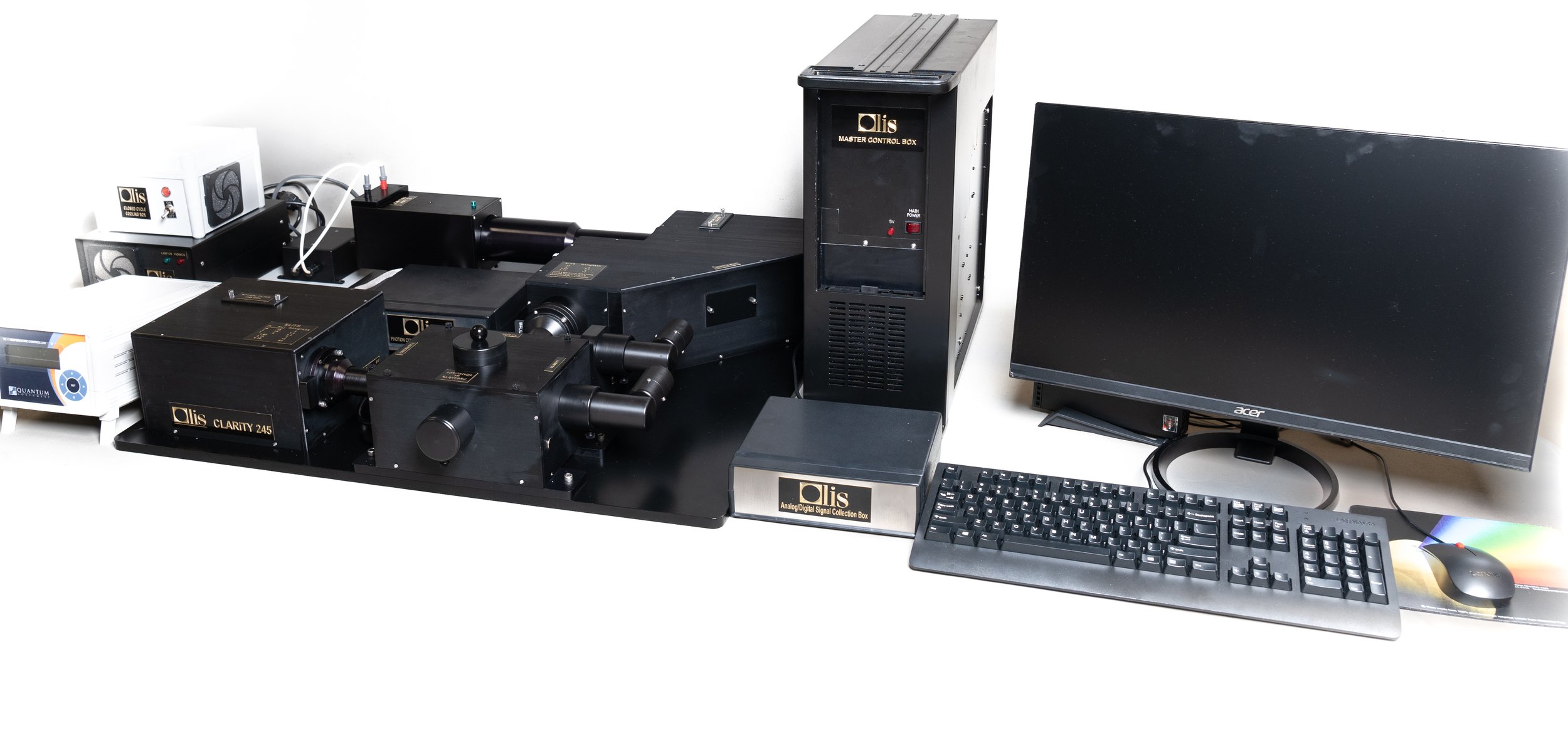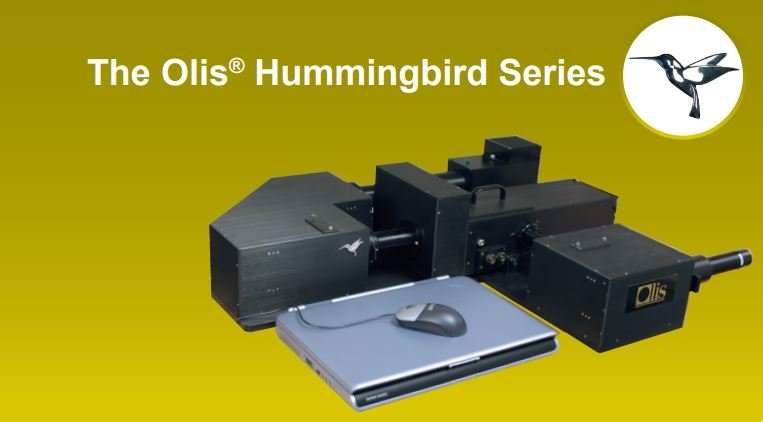
OLIS CLARiTY 2/45
Scanning models equally suited for fluorescence and absorbance
For the laboratory which wants highest sensitivity and wavelength scanning before and after the sample for use in both absorbance and fluorescence, these systems are ideal. The 45 has two OLIS single grating monochromators for highest sensitivity; the 245 uses one single grating monochromator plus an OLIS Hummingbird subtractive double for better stray light rejection and thus superior attributes for absorbance. Both employ a Hamamatsu photon counting PMT and broad-band, steady-state xenon arc lamp.
Standard Model Performance
Absorbance
Fluorescence
Download Specifications
Upcycle from Standard
Circular Dichroism
Circularly Polarized Luminescence
Accessories

“These data [of microparticles with ruthenium] are great improvement over anything we have seen before… We sent these samples to three other companies [which tried integrating sphere and specular reflectance spectroscopies] and got no useful data.”
Professor Ed Rosenberg,University of Montana
The Long
A 16 page chapter, circa 2020, on using CLARiTY:
“One thing is certain: one way to understand how a protein functions in an intact organism is to actually observe that protein as it functions in the intact organism. This paper provides an example of just such an observation.”
The Short
A single page piece, circa 2014, on using CLARiTY to follow metabolism in the electron transport chain:
“Today, research using a new integrating cavity spectrometer has demonstrated that isolated cell components do not act the same as when those components are in their native environment … when they are not in the environment in which they were designed to function, they may behave differently.”
The Short and Long of It.
Why Choose the OLIS CLARiTY 2/45?
#1
Success with turbid samples as a function of absorbance and fluorescence with exquisite sensitivity
#2
You expand your UV/Vis measurement options for virtually any sample, clear or not, in steady-state and scanning modes
#3
The same optics are used in the OLIS DSM 245, making it very economical for you to reconfigure this CLARiTY for CD and CPL, too.
Ask for a price quote today!
Tiny. Fast. Precise. Used in all new Absorbance, Fluorescence, and Circular Dichroism Spectrophotometers
Do you know what a “subtractive” double monochromator is?
We didn’t either, until we invented one. (And then another!) These alternatives to the “additive” double monochromators used by all the other commercial manufacturers have very useful advantages. Learn about their zero temporal dispersion and homogeneous output beams here.
Setting the new benchmark of performance.
For decades, spectrophotometrically working with turbid suspensions has proved elusive, because the measurement beam is scattered in all directions; only a fraction of it passes through the sample to the detector. “Apparent high absorbance” is the result, as these examples show.
Results from four popular and respected spectrophotometers compared with the Olis CLARiTY 1000
The sample was the most concentrated suspension of polystyrene particles in water (about 108 of the 1 micron particles/mL H2 O) as shown on page 2. Recall, polystyrene particles do not absorb light, so the correct answer is 0.0 AU.
The ubiquitous HP/ Agilent diode array spectrometer returns an answer that is more than 1.1 AU. The world-class dual beam, double monochromator based Cary 14 collected a maximum absorbance near 0.7 AU. As expected, better results were obtained from the “dual wavelength” spectrophotometer which was developed by Britton Chance expressly for the purpose of studying turbid samples.
In its split beam mode, the DW-2 reports absorbance of 0.5 AU and in its dual wavelength mode, an impressive <0.2 AU. Understandably, this dual wavelength model has held the honor as the “gold standard” of performance on turbid suspensions since the 1960s.
The CLARiTY, however, gets zero absorbance, give or take 0.01 AU.
And, as these and other data will show, scatter does not matter to the CLARiTY, including the UV, where even the “gold standard” cannot handle the scatter correctly.
Not sure if you should choose a diode array, CCD, or scanning spectrophotometer?
Reading this may help.
The CLARiTY Advantage
Integrating Cavity Spectrophotometers For a Powerful New Generation of Measurements
Everyone knows about spectrophotometers that use cuvettes. With cuvette spectrophotometers, accurate results are possible only with perfectly clear samples. When the sample is hazy or turbid, the light beam carrying the absorbance information is scattered, much of it away from the detector. The answer is therefore higher absorbance than is correct. Read more...
OLIS CLARiTY 2/45 Resources
Illustrative Experiments with CLARiTY: Check out some of the amazing experiments researchers have done with CLARiTY instruments. What will you do?
















